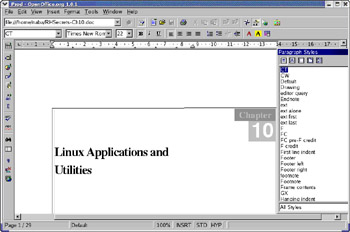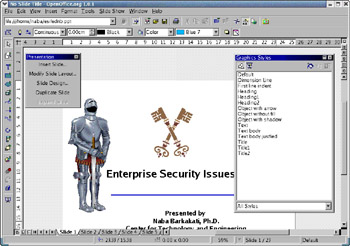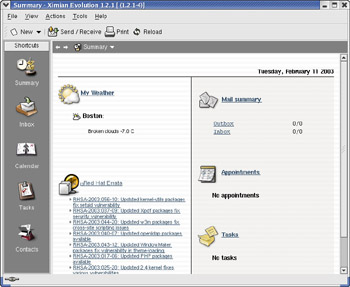Office Tools
Office Tools
This book’s companion CD-ROMs include several office tools, such as calendars, calculators, and spell checkers. The following sections describe a few of these office tools:
-
Ximian Evolution—A personal information manager (PIM) that includes email, calendar, contact management, and an online task list
-
OpenOffice.org Writer—A Microsoft Word-like word processor
-
OpenOffice.org Calc—A Microsoft Excel-like spreadsheet program
-
OpenOffice.org Impress—A Microsoft PowerPoint-like presentation program
-
KOrganizer—KDE calendar
-
Calculators—GNOME calculator and KDE calculator
-
Other applications—Commercially available office applications for Linux
Managing Your Inbox with Ximian Evolution
Red Hat provides Ximian Evolution as the mail reader and organizer for appointments, contacts, and tasks. You can learn more about Evolution at Ximian’s website at http://www.ximian.com/products/evolution/.
Select Main Menu>Internet>Email from the GNOME or KDE desktop. If this is your first time with Evolution, the Evolution Setup Assistant starts up (see Figure 10-2).

Figure 10-2: Setting Up Evolution for the First Time.
Click Next in the Welcome screen, and the Evolution Setup Assistant guides you through the following steps:
-
Enter your name and email address in the Identity screen, and click Next. For example, if your email address is joe@someplace.com, that’s what you enter.
-
Set up the options for receiving email, and click Next. Select the type of mail download protocol—POP (Post Office Protocol) or IMAP (Internet Message Access Protocol). Then provide the name of the mail server (for example, mail.comcast.net). You don’t have to enter the password for your email account right now; you will be prompted for a password when Evolution connects to the mail server the first time.
-
Provide further information about receiving email—how often to check for mail and whether to leave messages on the server—and then click Next. Typically, you would want to download the messages and delete them on the server; otherwise, the ISP would complain after your mail piles up.
-
Set up the options for sending email. Select the server type as SMTP (Simple Mail Transfer Protocol), then enter the name of the server such as smtp .comcast.net. If the server requires you to log in, click the check box that says Server requires authentication, then enter your user name (this is the user name you need to log in to your ISP’s mail server). Click Next.
-
Indicate if you want this email account to be your default account. Click Next.
-
Set your time zone by clicking on a map. Click Next.
-
Click Finish to complete the Evolution setup.
To access your email in Evolution, click the Inbox icon. Evolution opens your Inbox. If you had turned on the feature to automatically check for mail every so often, Evolution would have already prompted you for your mail password and downloaded your mail. The email inbox looks very much like any other mail reader’s inbox, such as the Outlook Express inbox.
To read a message, click on the message in the upper window of the Inbox, and the message text appears in the lower window.
To reply to the current message, click the Reply button on the toolbar. A message composition window pops up. You can write your reply and then click the Send button on the toolbar to send the reply.
To send a new email, click the New Message button on the Evolution toolbar. A new message composition window appears, and you can type your message in that window, then click Send.
To add an appointment in Evolution, click the Calendar button. Evolution then displays the calendar. You can move to the date of the appointment and double-click the time. A new window appears where you can type in the details of the appointment. When done, click the Save and Exit buttons on that window. Evolution then shows the appointment in the calendar, as shown in Figure 10-4.

Figure 10-4: Keeping Track of Appointments in Evolution’s Calendar.
| Insider Insight |
Ximian Evolution comes with extensive online help. Select Help>Table of Contents from the Evolution menu and A User’s Guide to Ximian Evolution appears in a Nautilus window. |
Writing with OpenOffice.org Writer
OpenOffice.org Write is a word-processing program. It’s part of an open-source office application suite, OpenOffice.org project (http://www.openoffice.org/). To start OpenOffice.org Writer, select Main Menu>Office>OpenOffice.org Writer from GNOME or KDE (you can also start OpenOffice.org Writer by clicking the panel button with icon showing papers next to a pen). OpenOffice.org Writer prompts you to register and displays a blank document in its main window. Using Writer is simple—it’s similar to other word processors such as Microsoft Word. For example, you can type text into the blank document, format text, and save text when done.
You can also open documents that you have prepared with Microsoft Word on a Windows machine. Figure 10-5 shows a Microsoft Word document being opened in OpenOffice.org Writer.

Figure 10-5: Preparing Documents in OpenOffice.org Writer.
When you save a document, by default Writer saves it in OpenOffice.org 1.0 Text Document format in a file with the .sxw extension.
| Insider Insight |
If you need to share OpenOffice.org Writer documents with Microsoft Word, save the documents in several formats including Microsoft Word 97/2000/XP, Microsoft Word 95, Microsoft Word 6.0, and Rich Text Format (.rtf). Microsoft Word can open .rtf files. |
I won’t explain how to use Writer because it is simple and intuitive to use. If you need it, online help is available. Select Help>Contents from the Writer menu. This brings up the OpenOffice.org Help window with help information on the Writer. You can then click the links to view specific help information.
Preparing Spreadsheets with OpenOffice.org Calc
Calc is the spreadsheet program in the OpenOffice.org application suite. To start Calc, select Main Menu>Office>OpenOffice.org Calc from the GNOME or KDE panel. The Calc program displays its main window, which looks similar to Windows-based spreadsheets, such as Microsoft Excel. (In fact, Calc can read and write Microsoft Excel format spreadsheet files.)
Use Calc in the same way you use Microsoft Excel. You can type entries in cells, use formulas, and format the cells (such as specifying the type of value and the number of digits after the decimal point). Figure 10-6 shows a typical spreadsheet in Calc.

Figure 10-6: Preparing Spreadsheets Using OpenOffice.org Calc.
When preparing the spreadsheet, use formulas you normally use in Microsoft Excel. For example, use the formula SUM(D2:D6) to add up the entries from cell D2 to D6. To set cell D2 as the product of the entries A2 and C2, type =A2*C2 in cell D2. To learn more about the functions available in OpenOffice.org Calc, select Help>Contents from the menu. This opens the OpenOffice.org Help window, from which you can browse the functions by category and click a function to read more about it.
To save the spreadsheet, select File>Save As. A dialog box appears, from which you can specify the file format, the directory location, and the name of the file. OpenOffice.org Calc can save the file in a number of formats, including Microsoft Excel 97/2000/XP, Microsoft Excel 95, Microsoft Excel 5.0, and text file with comma-separated values (CSV).
| Insider Insight |
If you want to exchange files with Microsoft Excel, save the spreadsheet in Microsoft Excel format (choose an appropriate version of Excel). Then you can transfer that file to a Windows system and open it in Microsoft Excel. |
Presenting Information with OpenOffice.org Impress
OpenOffice.org Impress is part of the OpenOffice.org office application suite. You can prepare briefing packages (slide presentations) using Impress. It’s similar to Microsoft PowerPoint. To run Impress, select Main Menu>Office>OpenOffice.org Impress from the GNOME or KDE desktop.
To begin working, select the type of document (paper or screen presentation) and any template you want to use. The template provides a style for the presentation package you want to prepare. You can also choose to open an existing document.
Figure 10-7 shows a typical slide presentation in Impress.

Figure 10-7: Preparing Briefing Packages in OpenOffice.org Impress.
The Impress window shows the first slide. The exact appearance depends on the document type and template you select. You can begin adding text and other graphic objects such as images, text, and lines to the slide.
To insert a new slide, select Insert Slide from the floating menu. A gallery of slide layouts appears in a dialog box. Click the style of slide you want in the dialog box. You can then add text and graphics to that new slide.
To save a presentation, select File>Save from the menu. For new documents, you have to provide a filename and select the directory in which to save the file.
| Insider Insight |
If you want to share the slides with someone who uses Microsoft PowerPoint, save the presentation in Microsoft PowerPoint 97/2000/XP format. |
Using Calculators
You have a choice of the GNOME calculator or the KDE calculator. Both are scientific calculators, and you can do the typical scientific calculations such as square root and inverse, as well as trigonometric functions, such as sine, cosine, and tangent.
To run the GNOME calculator, select Main Menu>Accessories>Calculator in the GNOME panel. Figure 10-8 shows the GNOME calculator.

Figure 10-8: The GNOME Calculator.
The KDE calculator has more features than the GNOME calculator. For example, it can perform calculations in hexadecimal, decimal, octal, and binary format. From the KDE desktop, you can start the KDE calculator by selecting Main Menu>Accessories>Scientific Calculator. The KDE calculator is intuitive to use.
Commercially Available Office Applications for Linux
Because office applications are important to many businesses as well as individuals, I want to briefly mention some of the commercial office applications available for Red Hat Linux. These commercial offerings include Anyware (formerly Applixware) Office, and StarOffice. These products do cost some money, but the cost is usually less than that for Microsoft Office—the leading office application suite for Windows. (In case you don’t know, Microsoft Office is a collection of several applications: Microsoft Word for word processing, Microsoft Excel for spreadsheets, Microsoft PowerPoint for presentation graphics, and Microsoft Access for databases.)
Another recent commercial product for Linux is CrossOver Office from CodeWeavers. With CrossOver Office, you can run your existing Microsoft Office applications such as Word, Excel, and PowerPoint under Linux and X Window System.
| Note |
This book’s companion CD-ROMs do not include any of these commercial office applications for Red Hat Linux, but I briefly describe them in the next few sections. You can visit each vendor’s website for more about the products. |
Running Microsoft Office in Linux with CrossOver Office
You probably have Windows and Microsoft Office installed on your PC. When you decide to run Red Hat Linux on the PC, you can continue to run the key Microsoft Office applications from the GNOME or KDE desktop. The convenience of running Microsoft Office in Linux comes in the form of a commercial product called CrossOver Office.
Getting Anyware Office
Anyware Office, formerly known as Applixware Office, is another prominent office application suite for all Linux distributions, including Red Hat Linux. In April 2000, Applix, Inc., formed a separate group—VistaSource, Inc.— that focuses solely on Linux applications.
Like other office suites, Anyware Office includes Words (for word processing), Spreadsheets (for spreadsheets), and Graphics and Presents (for presentation graphics). In addition, it also has Mail (an email interface) and Data (an interactive relational database browsing tool). Anyware Office can also read and write documents in Microsoft Office and Corel WordPerfect formats, as well as in several other file formats. Although trial versions are not offered, the entire Anyware Office suite is currently priced at less than $100 in the U.S.
You can learn more about Applixware at VistaSource’s website (http://www.vistasource.com/products/).
Getting StarOffice
StarOffice is another commercial office applications suite; it was created by StarDivision of Hamburg, Germany, and purchased by Sun Microsystems in 1999. StarOffice is a cross-platform solution—it runs on Linux, Windows 95/98/Me/NT/2000/XP, Sun Solaris SPARC, and Sun Solaris x86. Also, StarOffice is available in several languages: English, French, German, Spanish, Italian, and Swedish.








